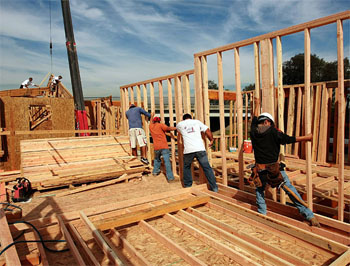Construction employment in February, spending in January climb to seven-year highs
 Editor’s note: Construction Citizen is proud to partner with AGC America to bring you AGC Chief Economist Ken Simonson's Data DIGest. Check back each week to get Ken's expert analysis of what's happening in our industry.
Editor’s note: Construction Citizen is proud to partner with AGC America to bring you AGC Chief Economist Ken Simonson's Data DIGest. Check back each week to get Ken's expert analysis of what's happening in our industry.
Nonfarm payroll employment in February increased by 242,000, seasonally adjusted, from January and by 2,672,000 (1.9%) over 12 months, and the unemployment rate stayed at 4.9%, the Bureau of Labor Statistics (BLS) reported last week. Construction employment rose by 19,000 for the month (to 6,631,000) and by 253,000 (4.0%) year-over-year (y/y). Industry employment reached the highest level since December 2008. Residential construction employment (residential building and specialty trade contractors) increased by 15,000 for the month and 155,100 (6.4%) y/y. Nonresidential employment (nonresidential building, specialty trades, and heavy and civil engineering construction) rose by 3,500 for the month and 98,300 (25%) y/y. The number of unemployed jobseekers who last worked in construction declined from 906,000 in February 2015 to 749,000, the lowest February figure since the series began in 2000. The unemployment rate for such workers dropped from 10.6% to 8.6%, the lowest February rate since 2006. (Industry unemployment data are not seasonally adjusted and should only be compared y/y, not across months.) Average hourly earnings—a measure of wages and salaries—in construction increased by 2.4% y/y, up from 1.3% in the previous 12 months.
Construction spending in January totaled $1.141 trillion at a seasonally adjusted annual rate, 1.5% above the upwardly revised December rate and up 10.4% y/y, the Census Bureau reported on Tuesday. The January level was the highest since October 2008 before adjusting for inflation but was still 5% short of the February 2006 peak. Spending growth was widespread among segments. Public construction jumped 4.5% for the month and 13% y/y. Those gains were driven largely by increases of 15% for the month and 34% y/y in highway construction, which benefited from a contrast between exceptionally warm weather in much of the U.S. in January 2016 compared to unusually cold and snowy conditions that depressed highway activity more than usual a year earlier. The other major public segment, educational construction, fell 1.9% from December but increased 12% y/y. Private residential spending was flat for the month but increased 7.7% y/y. New multifamily construction leaped 2.6% and 30%, respectively; new single-family construction, -0.2% and 6.6%; and residential improvements -0.7% and 2.0%. Private nonresidential spending rose 1.0% and 11%, respectively. In descending order of January size, manufacturing construction climbed 4.2% and 11%; power increased 1.7% and 10% (comprising a 28% y/y jump in oil and gas pipelines and field structures and a 1% rise in electric power facilities); commercial (retail, warehouse and farm) decreased 4.8% for the month and 0.8% y/y; and office rose 0.8% and 25%.
"Reports from the 12 Federal Reserve Districts continued to indicate that economic activity expanded" in most Districts during the first eight weeks of 2016, the Fed reported on Wednesday in the latest "Beige Book" (named for the color of its cover), a compilation of informal soundings of businesses. The districts are referenced by their headquarters cities. "Residential construction generally strengthened since the previous survey period, with only Philadelphia and Kansas City reporting declines. Contacts from the New York District reported sluggish single-family construction but robust multifamily construction. Boston, Richmond and San Francisco also reported strong growth in multifamily construction, and St. Louis noted an increase in speculative multifamily construction projects....Commercial occupancy rates rose in San Francisco, spurring higher lease rates and additional construction projects. Commercial vacancy rates were nearing or below prerecession levels in Minneapolis despite significant new commercial real estate construction, and St. Paul saw more commercial net absorption in the last year than in the previous ten years combined....Demand for commercial real estate space grew robustly in Chicago across retail, industrial and office segments, but there was concern that the lack of commercial construction and increased demand would lead to space shortages and price bubbles....With respect to nonresidential construction, the New York District reported that availability rates and asking rents held steady for office space, but that new office construction had weakened further. Commercial construction continued to expand at a robust pace in Minneapolis, but industrial construction slowed in the Chicago District....Contacts in New York, Richmond, Atlanta, Chicago, St. Louis, Minneapolis and Kansas City reported difficulty in finding skilled workers including information technology, engineering, specialty healthcare, construction, manufacturing and transportation employees." In the San Francisco District, "Construction costs continued to rise as the available supply of labor and material inputs was insufficient to meet rising demand."
Outlet centers are one retail niche that is expanding, even as more retailers close stores. "As retailers across the U.S. shutter hundreds of locations—sometimes leaving empty malls in their wake—Tanger Factory Outlet Centers continues to break ground on new properties," CNBC.com reported on Monday. "After opening four new centers in 2015, and with two more set to open by year-end, the company...is gearing up to open one or two new centers annually over the next two to three years....According to Value Retail News, 24 outlet centers are scheduled to open in the United States this year." In contrast, Sports Authority Inc. "sought bankruptcy protection Wednesday," the Wall Street Journal reported on Thursday, "and as many as 200 of the company's 464 stores may be earmarked for closure, court papers reveal." On February 26, CNBC.com reported, "Come June, there will be 18 fewer Kohl's stores across the U.S. [Meanwhile, the firm] said that it will pilot a smaller, 35,000-square-foot Kohl's in seven U.S. markets, an additional two off-price stores and enter the outlet space with 12 Fila stores.
The Data DIGest is a weekly summary of economic news; items most relevant to construction are in italics. All rights reserved. Sign up at www.agc.org/datadigest.


